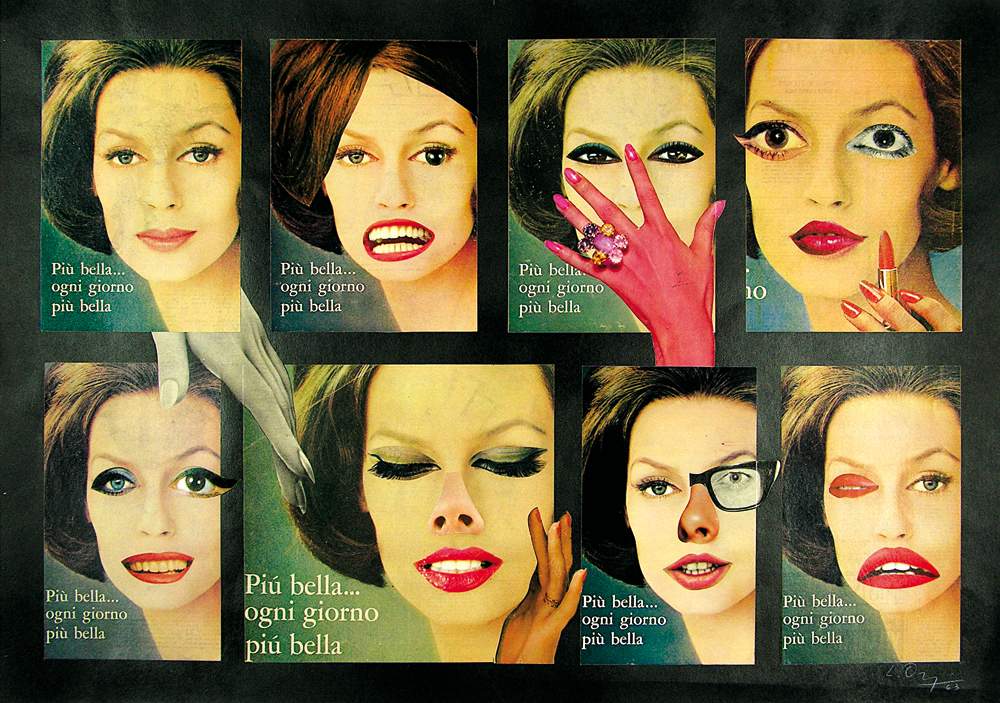On the occasion of the 60th anniversary of the birth of Gruppo 70, the Galleria d’Arte Moderna di Roma is hosting from December 1, 2023 to May 5, 2024 the exhibition La poesia ti guarda. Homage to Group 70 (1963-2023), curated by Daniela Vasta and promoted by Roma Capitale, Assessorato alla Cultura, Sovrintendenza Capitolina ai Beni Culturali, in collaboration with the Carlo Palli Archive of Prato, the Lamberto Pignotti Archive of Rome and the Bonotto Foundation of Molvena (VI). Organization by Zètema Progetto Cultura.
Referring explicitly to Futurist, Dadaist and Surrealist suggestions and continuing some of the cues of the historical avant-gardes, Group 70 moved in the context of the neo-avant-gardes after World War II, in a cultural moment in which various artists and groups felt the need for new aesthetic solutions in the field of visual image and poetic word. The recombination of heterogeneous verbal and iconographic materials gave rise to visual poems in which calligraphic-typographic signs and figures were integrated into a single semantic plane: poetry to look at and painting to read. Collage and photomontage, with deliberate borrowings from the world of advertising and mass communication in general, thus became the main tools for “playing” the cultural system by using its same iconographic and linguistic codes, stereotypes and myths, put back into circulation with new meanings and parodistic and subversive intentions.
Disbanded at the end of 1968, Gruppo 70 constituted a fundamental theoretical and poetic moment for all Italian visual poets. By extending the boundaries of poetry in the direction of the image and thus of gesture, performance and environmental installation, Gruppo 70 proposed to extend the boundaries of poetry, according to a multimedia, synaesthetic and multilingual attitude that introduced into the field of art a trait that remains distinctive of our time and our current way of perceiving, knowing and interpreting reality.
The exhibition focuses on the works of the 1960s and 1970s, with a particular emphasis on the period 1963-1968, in which the two founding conferences Art and Communication (Florence, Forte del Belvedere, May 24-26, 1963) and Art and Technology (Florence, Forte del Belvedere, June 27-29, 1964) are located, which are fundamental for understanding the theoretical context of the group and the’intention, elaborated broadly by semiologists, sociologists, writers, musicians and artists, of placing art in the broader territory of communication, in a direct confrontation with modernity. Through a selection of verbovisual works by the two founders Eugenio Miccini (1925-2007) and Lamberto Pignotti (1926), some of whose works come from the collection of the Gallery of Modern Art, by Ketty La Rocca (1938-1976), Lucia Marcucci (1933), Luciano Ori (1928 - 2007) and also by Roberto Malquori (1929) and Michele Perfetti (1931-2013), the exhibition aims to illustrate the artists’ poetic and aesthetic choices and modes of expression, with particular attention to the techniques favored by Group 70, such as collage, décollage, and photomontage.
The linguistic and figurative reservoirs they draw on come from the world of communication: newspapers, magazines, advertisements, rebuses, postcards, road signs, comic books, postage stamps, photostories, sheet music.
The works of the Group 70 artists, for example, reflect on thefemale image, in keeping with the emergence of gender issues in the public debate: Pignotti ironically depicts the little bourgeois family with its well-established roles(Dell’unificazione della cultura nel nostro paese, 1965-66) and demolishes with Marylin’s laughter the muscle fanatics(Vie nuove, 1965-66); Marcucci mocks the machista myth(Fuori serie, 1964) and the symbols of well-being(Il benessere provvisorio, 1965), Ori targets the imperative of beauty at all costs(Il filo della bellezza, 1963), Malquori the inconsistency of women’s magazines(Stop, 1964), Perfetti the erotic instrumentalization of women’s bodies(Mai di domenica, 1967).
Ketty La Rocca, on the other hand, focuses mainly on the components of language, reflecting on semantic equivocality(Segnaletiche, 1967-68) and on the sequence of progressive symbolic abstraction object-language-concept(Il discobolo in riposo, 1974), while in Appendice per una supplica (1971) her hands become an instrument, in a lexicon without an alphabet that expresses the urgency of telling her story as an artist and as a woman.
The exhibition is completed by a series of sound and video contributions intended to testify to experimentation in the fields of sound poetry, video and cinepoetry. Finally, a selection of documents from the period, including posters, playbills, invitations, brochures, magazines, essays, and artist’s books to understand the historical context and theoretical premises of the Group, testifying to its multifaceted activity also in the context of important public events and exhibitions.
The exhibition is accompanied by a catalog published by De Luca Editori d’Arte, with critical contributions by Daniela Vasta, Patrizio Peterlini and Lucilla Saccà, an unpublished interview with Lamberto Pignotti edited by Claudio Crescentini, and bio-bibliographical apparatus edited by Elena Rosica.
Hours: Tuesday through Sunday from 10 a.m. to 6:30 p.m. On Dec. 24 and 31 from 10 a.m. to 2 p.m.
Image: Luciano Ori, Il filo della bellezza (1963; collage on cardboard, 49.8 x 69.7 cm; Prato, Carlo Palli Collection)
 |
| Tribute exhibition to Group 70 at the Gallery of Modern Art in Rome |
Warning: the translation into English of the original Italian article was created using automatic tools. We undertake to review all articles, but we do not guarantee the total absence of inaccuracies in the translation due to the program. You can find the original by clicking on the ITA button. If you find any mistake,please contact us.